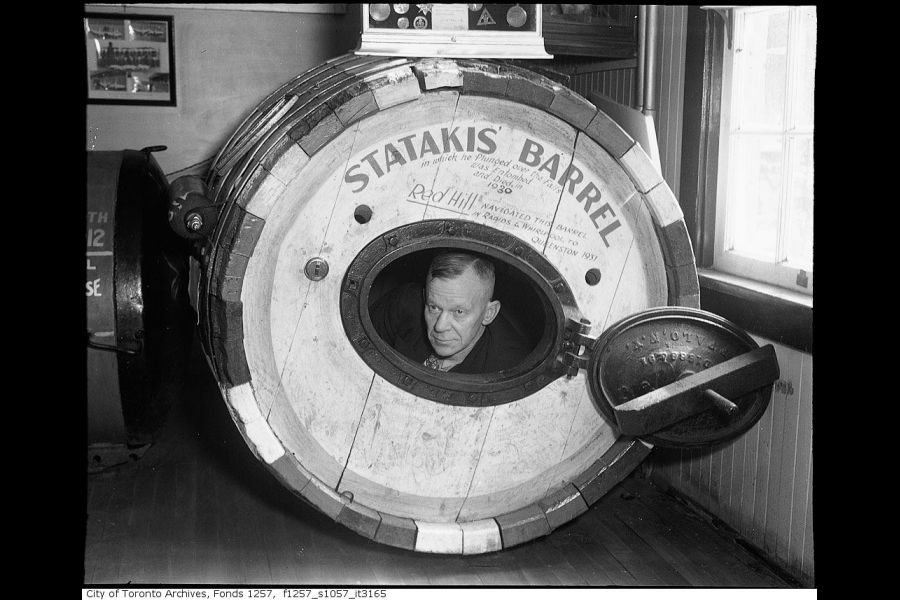Bill Hamilton
NOTL Writers' Circle
Back in 1948, the family business of the famed river man, Red Hill Sr. came under hard times and was subjected to seizure and sheriff’s sale. My grandmother, Rose Shields, purchased the estate and through passage in our family, it now belongs to me.
Growing up with the history of this unique group of people, we call “Daredevils,’’ I gained the greatest respect for the Niagara River and the Hill family.
As a young boy I always looked forward to trips with my dad to visit the display. I loved to read the stories about these bold and daring individuals. I was always mesmerized looking at these large barrels and what they represented.
The collection consists of the Hills’ “Red Barrel,” “The Silver Streak” and the famous “Stathakis Death Barrel.”
The Red Barrel, constructed of steel, weighing 620 pounds, saw father and son take it through the deadly Level 6 rapids of the Niagara River.
Imagine getting inside this steel drum, confined in darkness, cramped, with little room to move, the smell of steel and the thought this might be your last ride. Then in darkness, alone, anticipating a tumultuous ride through the most dangerous level of cascades, tossed, turned and upended time after time until you reach your destination.
On May 30, 1930, William Red Hill Sr. rode the barrel successfully through these treacherous rapids and the vortex of the Niagara River’s whirlpool.
He challenged the rapids again on Memorial Day 1931, only this time he chose the large wooden barrel of Stathakis for his daring trip. He ran into difficulty, getting trapped in the whirlpool, but his son, Red Jr., swam out to free his dad from a potentially deadly situation.
Once again, on July 8, 1945, the Red Barrel rode through the narrow gorge, but this time the occupant was Red Hill Jr.
He rode the dangerous waves like his dad, tossing and turning for about four and a half hours. He successfully ended this journey at the docks in Queenston, exiting the barrel bruised and battered.
The steel Silver Streak barrel rode the perilous rapids on Sept. 6, 1948, with Red Jr. as its passenger.
This barrel had a little different design, resembling a bullet and weighed 1,000 pounds.
Once again he hung on for dear life on this familiar course, confined for hours, being pounded against the steel surrounding him. He eventually reached his destination at the Queenston docks. With this latest success, he felt it was now time for a bigger challenge.
Red Jr. would learn the power of Niagara in 1951.
He followed through on a pledge to his family, to conquer the fury of Niagara Falls in a contraption of large inner tubes that he concocted.
He secured them by wrapping them in canvas and heavy netting. He called his creation “The Thing.” On Aug. 5, he launched his device into the swells of the upper rapids near Chippewa.
Approaching the falls, the netting somehow started breaking apart. Hill was swept over the 165-foot cataracts, unprotected, to his death. His mother cried out from shore looking for a son whose body would not be recovered until the next day.
Probably the most famous of the three vessels is the Stathakis Death Barrel.
George Stathakis was a Greek chef of slight build and short stature. He felt by going over the falls, he could make enough money to translate a book he had written from Greek to English and have it published.
He had a large, 2,000-pound wooden barrel built by amateurs. On July 5, 1930, the barrel was outfitted with a three-hour supply of oxygen and he was accompanied with his pet turtle “Sonny Boy.”
The barrel was towed out and released close to Chippewa. Twenty thousand onlookers watched. The wooden barrel quickly reached the precipice of the falls and plunged over the cataracts to an untimely fate.
The barrel was caught in a backflow keeping it behind the veil of the falls. Stathakis was trapped for many hours and suffocated, but his trusty shelled companion lived.
I learned some additional facts about William Red Hill Sr. that gave me a greater insight into this notable Canadian.
In 1896, he rescued his young sister from a fire in their family home. He was nine years old at the time.
He rescued Bobby Leach from his steel barrel in 1910.
On Feb. 4, 1912, he was able to lead more than 20 people to safety off the ice bridge that had formed below the falls. He felt a tremor and knew the ice was breaking.
A couple from Toronto and two teenagers from Cleveland were standing on the breaking ice. The teenagers heeded Hill’s direction to the Canadian shore but the couple headed toward the American shore.
The gap widened and they were trapped. The man struggled to aid his wife as they headed back toward Hill.
One of the teenagers still on the floe turned and ran to help. The other teen was pulled from the water to safety. Those trapped on the ice floe were doomed as the section of ice broke away, carrying them down to the deadly rapids and their tragic death.
William Sr. was a soldier in the First World War, during which he was gassed four times in combat.
His most notable rescue was in 1918 when two men were trapped in a runaway scow that had broken away up river and lodged in the upper rapids above the falls. He crawled across on a breaches buoy, clearing the roaring rapids and risking his life in order to complete the rescue.
He recovered 177 bodies from the river and saved 28 lives. At the time he was the only man in the world to have earned four life-saving medals.
William “Red” Hill Sr. died in 1942 at the age of 54.
Here are two YouTube websites showing the barrel rides: www.youtube.com/watch?v=P0YsZLuZO34, www.youtube.com/watch?v=S1y6RL7kpSI










